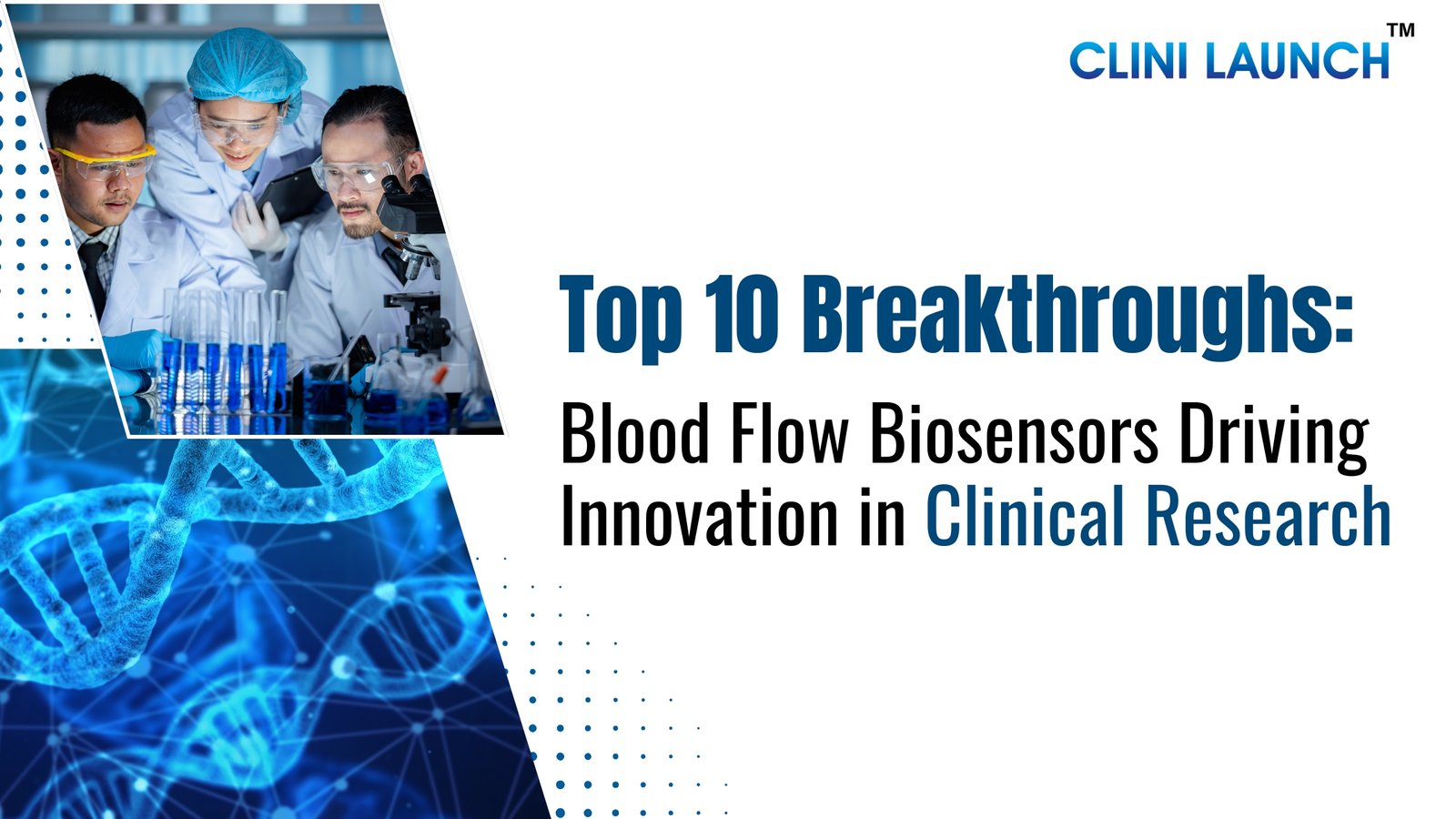The landscape of clinical research is continuously being reshaped by relentless technological innovation. Among the cutting-edge of these transformative technologies are blood flow biosensors, sophisticated devices refined to revolutionize how we understand, diagnose, and manage a load of physiological conditions.
This comprehensive exploration delves into the profound impact of blood flow biosensors on clinical research, highlighting their significance and potential for future advancements. We will explore the fundamental principles underpinning their operation, their diverse applications in clinical diagnostics, and the cutting-edge research that is propelling this field forward.
Enroll Now: Clinical Research
Understanding the Fundamental Principles of Blood Flow Biosensors
At its core, a blood flow biosensor is an analytical device designed to detect and measure the dynamic characteristics of blood flow within the circulatory system. These sensors leverage a variety of physical, chemical, or biological principles to convert the intricate patterns of blood movement into quantifiable signals.
The operational mechanisms can range from detecting changes in thermal properties, monitoring the velocity of red blood cells using ultrasonic or optical techniques, to assessing the concentration of specific analytes that are indicative of blood flow irregularities.
The integration of advanced materials science and nanotechnology has led to the development of highly sensitive and minimally invasive biosensors, paving the way for real-time monitoring and enhanced diagnostic capabilities in clinical research settings.
The Role of Biosensors in Contemporary Clinical Diagnosis

Biosensors in clinical diagnosis have become indispensable tools, offering rapid, accurate, and often cost-effective means for assessing a wide spectrum of health parameters. Beyond merely measuring blood flow, the broader category of biosensors encompasses devices like the Blood Glucose biosensor, which has profoundly impacted the management of diabetes.
These sensors demonstrate the transformative potential of biosensor technology in providing crucial physiological information directly to patients and healthcare professionals. The evolution of these diagnostic tools underscores the growing reliance on real-time data for personalized medicine and proactive healthcare strategies within clinical research protocols.
Multifaceted Applications of Blood Flow Sensors in Diverse Clinical Scenarios
The versatility of blood flow sensors extends across numerous clinical disciplines, making them invaluable assets in clinical research. In cardiovascular research, these sensors play a critical role in monitoring hemodynamic parameters, detecting early signs of vascular dysfunction, and assessing the efficacy of therapeutic interventions. For instance, continuous monitoring of blood flow can provide critical insights into the progression of atherosclerosis or the immediate impact of vasodilators.
Furthermore, in neurocritical care, blood flow sensors are essential for detecting cerebral vasospasms and ensuring adequate perfusion to the brain. The development of implantable and wearable blood flow sensors has further expanded their utility, allowing for long-term monitoring in ambulatory settings and providing researchers with a wealth of real-world data.
Cardiovascular Research: Monitoring Hemodynamics and Vascular Function
In cardiovascular medicine, precise and continuous monitoring of blood flow is paramount. Blood flow sensors enable researchers to gain a deeper understanding of hemodynamic parameters such as blood pressure, cardiac output, and peripheral resistance. These measurements are crucial for investigating the pathophysiology of various cardiovascular diseases, including hypertension, heart failure, and coronary artery disease.
Furthermore, blood flow sensors facilitate the assessment of vascular function by detecting subtle changes in blood flow patterns that may indicate endothelial dysfunction – an early marker of cardiovascular risk. Clinical trials evaluating novel therapies for cardiovascular conditions heavily rely on blood flow sensors to objectively measure treatment efficacy and patient outcomes.
Neurocritical Care: Detecting Cerebral Vasospasms and Ensuring Brain Perfusion
Maintaining adequate cerebral blood flow is critical in neurocritical care to prevent secondary brain injury following events such as stroke or subarachnoid hemorrhage. Blood flow sensors, particularly those employing transcranial Doppler ultrasound or thermal diffusion techniques, provide real-time information about cerebral perfusion.
Researchers utilize these sensors to monitor the development of cerebral vasospasms – a potentially life-threatening complication characterized by narrowing blood vessels in the brain. Early detection of vasospasms allows for timely intervention, improving neurological outcomes.
Moreover, blood flow sensors help optimize treatment strategies aimed at maintaining adequate brain perfusion in patients with various neurological conditions.
Peripheral Vascular Disease: Assessing Arterial and Venous Insufficiency
Peripheral vascular disease (PVD) affects the blood vessels outside the heart and brain, commonly leading to reduced blood flow to the limbs. Blood flow sensors are instrumental in diagnosing and monitoring PVD, allowing researchers to assess the severity of arterial and venous insufficiency.
Techniques such as Doppler ultrasound and photoplethysmography (PPG) are employed to measure blood flow velocity and volume in peripheral arteries and veins. This information is vital for evaluating the effectiveness of treatments, such as angioplasty or bypass surgery, and for monitoring disease progression.
Wearable blood flow sensors are also emerging as valuable tools for long-term monitoring of patients with PVD in their daily lives, providing researchers with longitudinal data on the impact of lifestyle modifications and therapeutic interventions.
Monitoring Graft Patency in Surgical Procedures
In various surgical procedures, particularly those involving vascular grafts, ensuring the patency (openness) of the graft is crucial for the success of the intervention. Blood flow sensors can be intraoperatively or postoperatively used to monitor blood flow through the graft, allowing for early detection of any potential blockages or narrowing.
This immediate feedback enables surgeons to take corrective actions promptly, improving the long-term outcomes of the surgery. Research in this area focuses on developing more sophisticated and less invasive blood flow monitoring techniques that can be seamlessly integrated into surgical workflows.
Advancements in Wearable Blood Flow Sensors for Continuous Monitoring
The arrival of wearable technology has paved the way for the development of compact and user-friendly blood flow sensors that can be integrated into wristbands, patches, or other wearable devices. These sensors offer the unparalleled ability to continuously monitor blood flow in real-time, providing a wealth of data that was previously inaccessible.
In clinical research, wearable blood flow sensors hold immense potential for longitudinal studies, allowing researchers to track subtle changes in blood flow patterns over extended periods in response to various stimuli, interventions, or lifestyle changes. This continuous monitoring capability can provide valuable insights into the early detection and management of chronic conditions.
Integration with Other Biosensor Technologies: Synergistic Effects

The power of blood flow biosensors is further amplified when integrated with other biosensor technologies. For instance, combining a blood flow sensor with a Blood Glucose biosensor in a continuous monitoring system can provide a more holistic understanding of the interplay between blood circulation and glucose metabolism, particularly relevant in the context of diabetes management research.
Similarly, integrating blood flow sensors with sensors that measure other vital signs like heart rate, oxygen saturation, and body temperature can offer a comprehensive physiological profile, enhancing the ability to detect subtle changes indicative of underlying health issues. This synergistic approach represents a significant trend in clinical research, promising more nuanced and informative data for advancing medical knowledge.
Emerging Trends and Future Directions in Blood Flow Biosensor Research
The field of blood flow biosensor research is dynamic and constantly evolving, with several exciting trends shaping its future. One prominent area of focus is the development of more sensitive and selective biosensors that can detect subtle changes in blood flow dynamics associated with specific disease states. Researchers are also exploring the use of novel materials, such as flexible and stretchable polymers, to create more comfortable and unobtrusive wearable sensors.
Furthermore, the integration of artificial intelligence (AI) and machine learning (ML) algorithms with blood flow biosensor data is opening new avenues for data analysis, enabling predictive diagnostics and personalized treatment strategies in clinical research.
Miniaturization and Enhanced Sensitivity for Point-of-Care Diagnostics
A key trend in blood flow biosensor research is the push towards miniaturization, enabling the development of smaller, more portable, and less harmful devices. This miniaturization is often accompanied by efforts to enhance the sensitivity of these sensors, allowing for the detection of even minute changes in blood flow that may be indicative of early-stage disease. These advancements are particularly relevant for point-of-care diagnostics, where rapid and accurate blood flow assessments are needed at the patient’s bedside or in remote settings, facilitating timely clinical decision-making.
Novel Materials and Fabrication Techniques for Improved Performance
The performance and functionality of blood flow biosensors are heavily influenced by the materials used in their fabrication. Researchers are actively investigating novel materials, such as biocompatible polymers, nanomaterials, and conductive inks, to develop sensors with improved sensitivity, stability, and durability. Advanced fabrication techniques, including microfluidics and 3D printing, are being employed to create complex sensor architectures with enhanced functionalities and tailored properties for specific clinical applications.
Integration of Artificial Intelligence and Machine Learning for Data Analysis
The vast amounts of data generated by continuous blood flow monitoring necessitate the use of data analysis tools. The integration of AI and ML algorithms with blood flow biosensor technology is proving to be a powerful approach for extracting meaningful insights from complex datasets. These algorithms can identify subtle patterns and anomalies in blood flow dynamics that may not be apparent to the human eye, enabling early disease detection, risk stratification, and personalized treatment recommendations in clinical research settings.
Challenges and Opportunities in the Translation to Clinical Practice

Despite the significant advancements in blood flow biosensor technology, several challenges remain in translating these innovations into routine clinical practice. These challenges include ensuring the accuracy and reliability of the sensors in diverse patient populations, addressing issues related to biocompatibility and long-term stability of implantable devices, and navigating the regulatory hurdles for medical device approval.
However, these challenges also present significant opportunities for researchers, engineers, and clinicians to collaborate and develop robust and clinically validated blood flow biosensor technologies that can ultimately improve patient care and outcomes.
Final Thoughts
Blood flow biosensors stand at the cusp of a transformative era in clinical research. Their ability to provide continuous, real-time information about the circulatory system offers unprecedented opportunities for advancing our understanding of human physiology and disease. From monitoring cardiovascular health to ensuring adequate brain perfusion and assessing peripheral vascular function, these versatile devices are becoming increasingly indispensable tools for researchers and clinicians alike.
As technology continues to evolve with advancements in miniaturization, sensitivity, novel materials, and AI integration, the potential for blood flow biosensors to revolutionize clinical diagnosis and personalized medicine is immense.
Ready to be at the forefront of clinical research innovation?
Contact CliniLaunch Research today to explore our comprehensive clinical research services and discover how our expertise can help you leverage the power of cutting-edge technologies like blood flow biosensors to advance your research goals. Visit us CliniLaunch Research at to learn more.
References
Self-adaptive epidermal blood flow sensor for high-flux vascular access monitoring of hemodialysis patients
https://www.nature.com/articles/s41528-024-00342-y
Arterial Blood Flow Sensor
https://link.springer.com/chapter/10.1007/978-3-540-89208-3_277
Biosensor for rapid and accurate detection of cardiovascular biomarkers: Progress and prospects in biosensors
https://www.sciencedirect.com/science/article/pii/S2590137023000857






